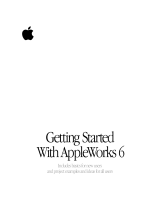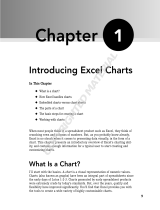Page is loading ...

AppleWorks 5
User’s Manual
Includes instructions for using your software
FOR WINDOWS 95 / NT 4.0

K Apple Computer, Inc.
© 1998 Apple Computer, Inc. All rights reserved.
Under the copyright laws, this manual may not be copied, in whole or in part, without the written consent of Apple. Your rights to the
software are governed by the accompanying software license agreement.
The Apple logo is a trademark of Apple Computer, Inc., registered in the U.S. and other countries. Use of the “keyboard” Apple logo
(Option-Shift-K) for commercial purposes without the prior written consent of Apple may constitute trademark infringement and unfair
competition in violation of federal and state laws.
Every effort has been made to ensure that the information in this manual is accurate. Apple is not responsible for printing or clerical
errors.
Apple Computer, Inc.
1 Infinite Loop
Cupertino, CA 95014-2084
408-996-1010
http://www.apple.com
Apple, the Apple logo, AppleWorks and the AppleWorks design, Claris, and QuickTime are trademarks of Apple Computer, Inc.,
registered in the U.S. and other countries.
Other company and product names mentioned herein are trademarks of their respective companies. Mention of third-party products is
for informational purposes only and constitutes neither an endorsement nor a recommendation. Apple assumes no responsibility with
regard to the performance or use of these products.
Simultaneously published in the United States and Canada.
Equation Editor in AppleWorks
Equation Editor in AppleWorks 5 is a special version of MathType™ by Design Science. If you frequently create documents with
equations, you may find MathType is better suited to your needs. MathType is as easy to use as Equation Editor and has many extra
features to help you save time and create more complex mathematical formulas in documents.
For further information about upgrading Equation Editor to MathType, contact your software dealer or Design Science directly:
Design Science, Inc.
4028 Broadway
Long Beach, CA 09803
To ll Free: 800-827-0685
International: 562-433-0685
FAX: 562-433-6969
e-mail: [email protected]
Web site: http://www.mathtype.com

III
Contents
Chapter 1: Introduction
Registration and customer support 1-1
How to start 1-1
Using Help and the User’s Manual together 1-2
Using AppleWorks Help 1-3
Opening and closing AppleWorks Help 1-3
Using the Help contents 1-4
Navigating AppleWorks Help 1-4
Using the onscreen Help index 1-5
Learning more about onscreen Help 1-7
Getting additional help 1-7
Working with AppleWorks 1-8
What’s a document? 1-8
Document types 1-8
Text (word processing) documents 1-9
Draw documents 1-10
Paint documents 1-11
Spreadsheet documents 1-11
Database documents 1-12
Communications documents 1-13
Where to go from here 1-14
Chapter 2: Creating, opening, and printing documents
Starting AppleWorks 2-1
Creating a document 2-1
Creating a blank document 2-2
Using an Assistant 2-3
Using stationery 2-5
Saving a document 2-7
Opening a document 2-8
Finding documents 2-9
Linking to other documents 2-9

IV AppleWorks 5 User’s Manual
Saving document formatting as templates (stationery) 2-10
Setting up regular stationery 2-10
Setting up default stationery 2-11
Creating stationery 2-11
Opening stationery 2-12
Identifying your documents 2-13
Protecting documents with passwords 2-14
Importing and exporting documents 2-15
Closing a document and leaving AppleWorks 2-16
Printing a document or Help topic 2-16
Chapter 3: Basics
Working with windows 3-1
Viewing windows 3-2
Arranging windows 3-3
Going to a page 3-4
Using the tool panel 3-4
Using the button bar 3-5
Switching button bars 3-5
Showing, hiding, and positioning the button bar 3-6
Customizing the button bar 3-6
Adding and removing buttons 3-6
Creating your own button bar 3-7
Using palettes 3-7
Working with frames 3-9
Working in an AppleWorks document 3-10
Cutting, copying, and pasting 3-10
Changing your mind 3-10
Previewing pages for printing 3-11
Using rulers 3-12
Creating headers and footers 3-12
Adding a date or time 3-14
Numbering pages 3-15
Setting margins 3-16
Changing the page orientation and size 3-16

Contents V
Using libraries 3-17
Creating, opening, and saving libraries 3-18
Working with the library palette 3-18
Duplicating, deleting, and moving library items 3-19
Viewing library items 3-19
Setting preferences 3-20
Chapter 4: Text (word processing)
When to use a word processing document 4-1
Text basics 4-2
Creating a word processing document or frame 4-2
About the word processing window 4-2
Working with text frames 4-3
Typing text 4-4
Typing equations 4-5
Selecting text 4-5
Cutting, copying, and pasting text 4-6
Showing formatting characters 4-6
Changing text appearance 4-7
Changing paragraph formats 4-8
Setting and changing tabs 4-10
Indenting paragraphs 4-10
Adding bullets, numbers, and checkboxes to paragraphs 4-11
Aligning paragraph text 4-12
Changing line and paragraph spacing 4-12
Copying text ruler settings 4-13
Sorting paragraphs 4-13
Outlining 4-13
Creating an outline 4-14
Modifying and removing outline labels 4-15
Rearranging outline topics 4-16
Collapsing and expanding outline topics 4-16
Modifying an outline style 4-17
Creating tables 4-18
Working with pages 4-19

VI AppleWorks 5 User’s Manual
Creating a title page 4-19
Creating and changing columns 4-20
Breaking a page or column 4-21
Scrolling pages 4-22
Dividing a document into sections 4-22
Inserting and deleting a section 4-23
Formatting sections 4-23
Varying the number of columns on a page 4-25
Numbering sections 4-25
Adding footnotes and endnotes 4-26
Finding and changing text 4-27
Finding special characters 4-28
Using writing tools 4-28
Checking your spelling 4-29
Hyphenating words 4-30
Finding synonyms 4-30
Changing dictionaries 4-31
Counting words 4-31
Adding pictures and frames to text 4-31
Wrapping text around pictures 4-32
Creating links in word processing documents 4-34
Chapter 5: Drawing
When to use a drawing 5-1
Drawing basics 5-2
Creating a drawing 5-2
About the draw window 5-2
What are objects? 5-3
Using the drawing tools 5-3
Selecting and deselecting objects 5-6
Using the graphics ruler and grids 5-7
Moving objects 5-7
Duplicating, copying, and deleting objects 5-8
Changing the appearance of objects 5-9
Changing lines, borders, colors, patterns, and textures 5-9

Contents VII
Copying an object’s attributes 5-11
Resizing objects 5-12
Reshaping and smoothing objects 5-13
Connecting objects 5-13
Arranging objects 5-15
Locking objects to prevent changes 5-16
Creating a master page 5-17
Adding pages to a draw document 5-18
Creating custom colors, patterns, gradients, and textures 5-18
Adding clip art 5-19
Adding text, spreadsheet, or paint frames 5-19
Creating links in draw documents 5-21
Chapter 6: Painting
When to use a painting 6-1
Painting basics 6-2
Creating a painting 6-2
About the paint window 6-3
Working with paint frames 6-3
Working with images 6-4
Using the painting tools 6-4
Setting lines, colors, patterns, and textures 6-6
Selecting and moving images 6-7
Deleting, copying, and duplicating images 6-8
Magnifying an image 6-9
Transforming a selection 6-9
Reshaping a selection 6-9
Resizing or turning a selection 6-10
Coloring and tinting images 6-10
Replacing images 6-11
Adding text and spreadsheets 6-12
Adding clip art 6-13
Customizing resolution and depth 6-13
Working with large files 6-13
Changing the size of a painting 6-14

VIII AppleWorks 5 User’s Manual
Creating links in paint documents 6-14
Chapter 7: Spreadsheet
When to use a spreadsheet 7-1
Spreadsheet basics 7-2
Creating a spreadsheet 7-3
About the spreadsheet window 7-3
Working with spreadsheet frames 7-4
Typing in a spreadsheet 7-5
Selecting cells and ranges 7-5
Modifying cell data 7-6
Editing data 7-6
Moving data 7-7
Copying and deleting data 7-8
Filling a range of cells 7-8
Formatting cell data 7-9
Sorting cell data 7-11
Locking cell data 7-12
Naming cells and ranges 7-12
Assigning names to cells 7-13
Editing and deleting names 7-13
Using named cells in formulas 7-14
Replacing cell references with named cells 7-14
Example 1: Using cell names in a formula 7-15
Example 2: Replacing named cells with cell references 7-16
Changing cells, rows, and columns 7-16
Resizing or hiding rows and columns 7-16
Inserting and deleting cells, rows, and columns 7-17
Changing the number of rows and columns 7-18
Adding borders, colors, and patterns to cells 7-18
Locking row and column titles 7-19
Adding and removing page breaks 7-19
Changing the display 7-19
Printing a spreadsheet document 7-20
Working with formulas 7-20

Contents IX
Understanding formulas 7-21
Cell references in formulas 7-22
Entering formulas 7-23
Calculating formula results 7-24
Making corrections 7-24
Examples: Entering formulas 7-25
Working with functions 7-26
Entering functions 7-27
Example: Using the AVERAGE function 7-27
Displaying data in charts (graphs) 7-28
Making charts 7-29
Changing chart options 7-29
Deleting, copying, or moving a chart 7-30
Enhancing a chart’s appearance 7-31
Adding pictures or a text frame 7-32
Creating links in spreadsheet documents 7-34
Chapter 8: Database
When to use a database 8-1
Database basics 8-1
What’s a database? 8-1
Using Browse, List, Find, and Layout modes 8-2
Creating a database document 8-3
Example: Creating a simple database 8-4
Part 1: Start a new database document 8-4
Part 2: Define two fields 8-4
Part 3: Enter two values into the fields 8-5
Part 4: Make new records 8-5
Part 5: Finish entering data in the new records 8-5
Part 6: Close the database 8-5
Designing a database 8-6
Defining database fields 8-7
Adding fields to an existing database 8-7
Assigning field types 8-7
Checking or entering data automatically 8-9

X AppleWorks 5 User’s Manual
Defining calculation and summary fields 8-10
Adding, changing, and deleting fields 8-12
Entering data in fields 8-12
Adding records 8-14
Changing the tab order 8-14
Duplicating, deleting, and moving records 8-15
Moving through records 8-15
Viewing records 8-16
Playing movies in multimedia fields 8-17
Working with rows and columns in List mode 8-17
Selecting rows and columns 8-18
Resizing rows and columns 8-18
Moving columns and formatting data 8-19
Selecting and hiding records 8-20
Sorting records 8-21
Finding information 8-23
Finding text 8-23
Finding records with a find request 8-23
Saving a find request (named search) 8-25
Matching records 8-26
Working with layouts 8-27
Understanding layouts 8-27
Creating a layout 8-29
Editing a layout 8-31
Deleting, duplicating, and renaming a layout 8-32
Changing the appearance of data 8-32
Presenting and summarizing data with parts 8-34
Copying summary data 8-36
Resizing and deleting parts 8-36
Creating reports 8-36
Importing data from other documents 8-37
Printing a database document 8-38
Printing labels 8-39
Closing up space when you print 8-39

Contents XI
Chapter 9: Beyond the basics
Creating links 9-1
Creating book marks 9-2
Creating document links 9-2
Editing links 9-3
Deleting links 9-4
Going to a specific link 9-4
Sorting links 9-5
Using styles 9-5
About the stylesheet palette 9-6
Styles in documents and frames 9-7
Applying a style 9-8
Creating a style 9-9
Turning off a style 9-11
Example: Applying and creating styles 9-11
Editing styles 9-13
Copying, pasting, and deleting styles and properties 9-15
Importing and exporting styles 9-16
Creating a slide presentation 9-16
Creating slides 9-16
Setting up slides 9-17
Reordering slides 9-19
Showing the slides 9-19
Merging data into documents (mail merge) 9-19
Setting up the database 9-20
Preparing the merge document 9-21
Printing the merge documents 9-22
Addressing envelopes 9-22
Using the Envelope Assistant 9-23
Setting up and creating envelope stationery 9-23
Addressing an envelope 9-24
Linking frames 9-24
Working with movies 9-26
Adding a movie to a document 9-27

XII AppleWorks 5 User’s Manual
Playing a movie 9-27
Creating and editing custom buttons 9-28
Using macros 9-29
Including other applications in your documents (OLE) 9-30
Understanding Object Linking and Embedding 9-30
Inserting OLE objects 9-31
Working with OLE objects 9-32
Chapter 10: Communications
When to use a communications document 10-1
Communications basics 10-1
What you need 10-1
Communications terms and concepts 10-2
Creating a communications document 10-2
About the communications window 10-3
Connecting to another computer 10-3
Changing the communications program 10-4
Chapter 11: AppleWorks and the Internet
About the Internet and the Web 11-1
About browsers 11-2
Selecting a browser 11-2
Connecting to the Web 11-3
Creating a Web page 11-3
Designing your Web page 11-3
Creating an HTML file 11-4
Adding pictures 11-5
Linking Web pages 11-5
Saving a document in HTML format 11-9
Opening and editing HTML files 11-9
Working with electronic mail 11-10
Index

Chapter 1: Introduction
This User’s Manual introduces you to the AppleWorks 5 application from
Apple Computer, Inc. AppleWorks is an all-in-one software package
offering seamless integration of word processing, outlining, presentations,
drawing, painting, spreadsheet computation and charting, database
management, and communications, including support for HTML and linking
to the Internet.
Registration and customer support
Please take the time to mail the product registration card included with
AppleWorks or register your copy of AppleWorks at the following Web site:
1 http://www.applereg.com
For information about customer support, see the Apple Service Directory
included with your copy of AppleWorks or see the following Web site:
1 http://support.info.apple.com/support/supportoptions/
supportoptions.html
For information about AppleWorks, see the following Web site:
1 http://www.apple.com/appleworks
How to start
This User’s Manual is designed to get you started quickly, whether you’re a
new or experienced AppleWorks user.
If Do this
You’re new to AppleWorks
or want a complete
understanding of
AppleWorks
Become familiar with Windows 95 techniques, such as using
the mouse and saving documents. For such information, see the
documentation that comes with your computer.
View the onscreen tour, “Introduction to AppleWorks,” to
understand what AppleWorks is all about. To begin the tour,
click the Start menu and choose Programs. Then choose
Introduction to AppleWorks from the AppleWorks menu.
Start AppleWorks (click the Start menu, choose Programs, and
then choose AppleWorks from the AppleWorks menu) and
practice using AppleWorks while reading this User’s Manual
and referring to onscreen Help.

1-2 AppleWorks 5 User’s Manual
Using Help and the User’s Manual together
This User’s Manual and AppleWorks Help, a comprehensive onscreen Help
system, are designed to work together.
Text marked with a bar, in the margin or within the text, lists index entries
to AppleWorks Help topics. These Help topics provide more information
about a feature.
To look up an index entry in AppleWorks Help, start AppleWorks, choose
AppleWorks Help Index from the Help menu, and then scroll to the entry. For
complete instructions for using the index to onscreen Help, see “Using the
onscreen Help index” on page 1-5.
Special information in this User’s Manual looks like this:
Note, Tip, or titled messages give extra or helpful information about a subject.
Important messages alert you to situations that require attention, such as an
action that you can’t undo.
Glossary terms are defined in this manual and AppleWorks Help. They
appear in italic in the this manual, and underlined with a dotted line in Help.
Glossary terms are also listed in the this manual’s index. For example, to find
the definition of cell range, look up Cell range, described.
You’ve used AppleWorks
before
Read the rest of this chapter to learn how to use this User’s
Manual and AppleWorks Help together.
Start AppleWorks (see “Starting AppleWorks” on page 2-1 if
you need help). Then review the list of new features in
AppleWorks (see the AppleWorks 5 Installation Manual, or
choose AppleWorks Help Contents from the Help menu, and then
click New features in AppleWorks).
As necessary, review AppleWorks Help topics and the chapters
in this book to learn more about specific procedures.
For information on In the Help index,* see:
an AppleWorks feature
E index entries for relevant topics are listed here
If Do this
In the Help index,* see:
E index entries relating to the
current section are listed here

Introduction 1-3
Using AppleWorks Help
AppleWorks Help completely documents all AppleWorks features. As you
become comfortable working with AppleWorks, you’ll be able to find all the
information you need in AppleWorks Help.
Opening and closing AppleWorks Help
To open Help when AppleWorks is running, click in the AppleWorks
window. Then press F1 to display the Contents screen, or choose a command
from the Help menu.
In many dialog boxes you see a button. You can click the button to get
Help for the task you’re performing. (You can also press F1 for the current
task when the dialog box is displayed.)
Note Whenever you open AppleWorks Help, you start the Windows Help
application, which runs independently of AppleWorks. This means you can
open AppleWorks Help even when AppleWorks isn’t running. To do so,
click the Start menu and choose Programs. Then choose AppleWorks Help from
the AppleWorks menu.
To see Choose
Topic titles in a table of contents AppleWorks Help Contents
An alphabetical list of index entries AppleWorks Help index
Information on navigating and using
AppleWorks Help
AppleWorks Help Contents, and then click Getting Help
Click this button (or
press F1) for Help for
the current task

1-4 AppleWorks 5 User’s Manual
Using the Help contents
When you open AppleWorks Help, you see a list of Help topics, much like
the table of contents in a book.
Navigating AppleWorks Help
When you select a topic, you see the AppleWorks Help window. To navigate
AppleWorks Help, click buttons and underlined text.
Double-click a topic
you want to see
Double-click a book icon
to see a list of subtopics
Click to see the index
Click to search for specific
words in the AppleWorks
Help topics
Click any time to return
to the contents window

Introduction 1-5
Tip To see a sequential list of topics you’ve viewed, choose Display History
Window from the Help window’s Options menu.
Using the onscreen Help index
To browse through the index, click the button in the AppleWorks
Help window or the Index tab in the Contents window, and then scroll
through the alphabetical list. To go to a specific index entry—for example,
if you’re using the index entry in this manual to direct you to a topic in
Help—type the first few letters of the entry. (To see one screen of entries at
a time, press Page Up or Page Down.)
Click to see the
index
Click to see the
table of contents
Click to move to the next
or previous related topic
Click to retrace your
path through Help
Click underlined text to
jump to a topic or see a
list of related topics
Click dotted text to
see a definition
Click to minimize onscreen
Help and le
Click to print the current topic

1-6 AppleWorks 5 User’s Manual
To return to the same place in the index, click the button.
*
Choose Index from the Help menu and type the first few letters of the entry. Double-click the
entry and then double-click a topic.
Type all or part of
the index entry
In the Help index,* see:
E frames
You see this in the User’s Manual
Double-click a topic
you want to see
You see a list of topics (if
there’s only one topic for that
entry, you see the topic)
Then double-click the
entry to select it

Introduction 1-7
Learning more about onscreen Help
Refer to AppleWorks Help for more tips on locating information and
customizing onscreen Help.
Getting additional help
Here are more ways to learn about AppleWorks:
Tip To show or hide Tool Tips or the status bar, choose Preferences from the
Edit menu. In the Preferences dialog box, choose General from the Topic
pop-up menu, and then select or deselect Tool Tips or Show Status Bar.
*
Choose Index from the Help menu and type the first few letters of the entry. Double-click the
entry and then double-click a topic.
For information on In the Help index,
* see:
Adding your own notes to a Help topic
E Help, customizing
Copying Help topics into an existing document
E Help, copying
Finding text within a Help topic
E Help, finding
Marking topics you use often
E Help, customizing
Printing one or more Help topics
E Help, printing
Referring to a glossary of AppleWorks terms
E glossary
To Do this
Take an onscreen tour of the most important
AppleWorks features and concepts
Choose Introduction to AppleWorks from the
AppleWorks Help menu.
Use automated assistance in creating
various types of documents (such as
newsletters and presentations)
Choose New from the File menu, and then select
Use Assistant or Stationery. Choose a category from the
pop-up menu, and then select an Assistant from
the scrolling list. (For more information about
Assistants, see “Using an Assistant” on page 2-3.)
Use automated assistance in performing
complex tasks (such as adding footnotes
or tables to a document)
Choose AppleWorks Assistants from the AppleWorks
Help menu.
Use Tool Help to see the names of
AppleWorks tools, controls, and buttons
(when they’re displayed)
Hold the pointer over the item for a few seconds.
For tools, controls, and buttons, you see a pop-up
label.
See brief descriptions of AppleWorks
menu commands, tools, controls, and
buttons (when they’re displayed)
Hold the pointer over the item for a few seconds.
You see information about the item in the status
bar, at the bottom of the window.

1-8 AppleWorks 5 User’s Manual
Working with AppleWorks
With the AppleWorks application, you can do all the jobs you perform most
often on a personal computer: word processing, outlining, drawing and
painting, presentations, spreadsheet computation and charting, database
management, and telecommunications. The rest of this chapter describes the
different types of work you can do with AppleWorks.
First go through the introductory material (both in print and onscreen) that
you received with your computer. When you’re ready to learn about
AppleWorks, start by running the onscreen tour, “Introduction to
AppleWorks.” For instructions on starting AppleWorks and running the
onscreen tour, see “How to start” on page 1-1. The tour is an easy way to see
what AppleWorks can do for you.
What’s a document?
You use the AppleWorks application to create documents. A document is a
computer file in which you enter information. You can create, open, change,
save, print, delete, and duplicate documents. When saved, a document
appears as an icon in a folder.
When you create a document, it appears in its own window, with the tools
needed for that document type.
When a document is open, you see its contents (such as a letter or a drawing)
displayed in the window. When printed, a document looks just as it does on
the screen.
Document types
You can create six different types of documents with AppleWorks—
word processing, drawing, painting, spreadsheet, database, and
communications. As you look at the document windows on the following
pages, notice that each document type has its own menus and tools.
While each type of document is mainly for a certain type of work such as
writing a letter or drawing a picture, you can use AppleWorks to combine
different kinds of work within a single document by using a frame, a view of
one document within a different type of document. For example, you can add
a spreadsheet to a letter without first creating a spreadsheet document.
/



